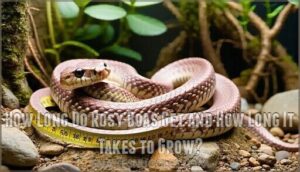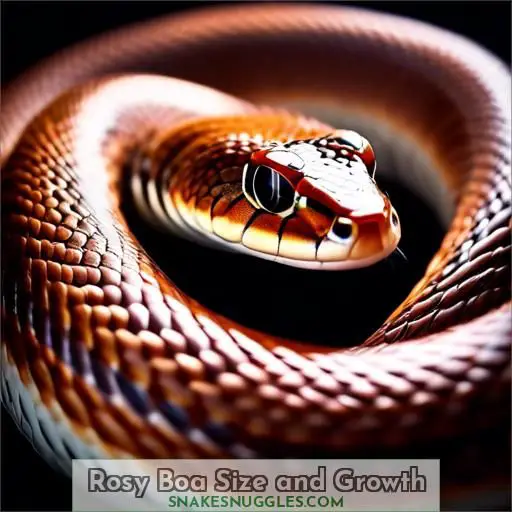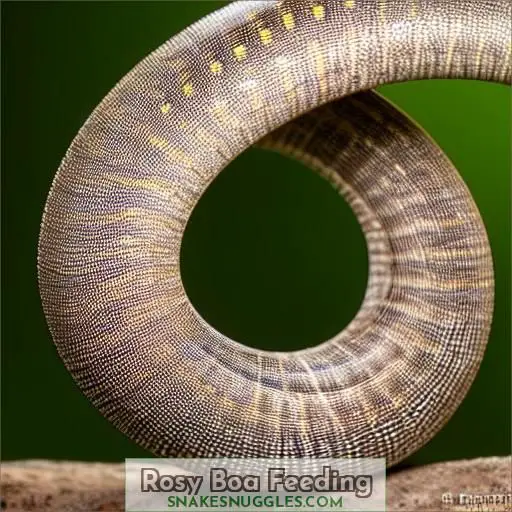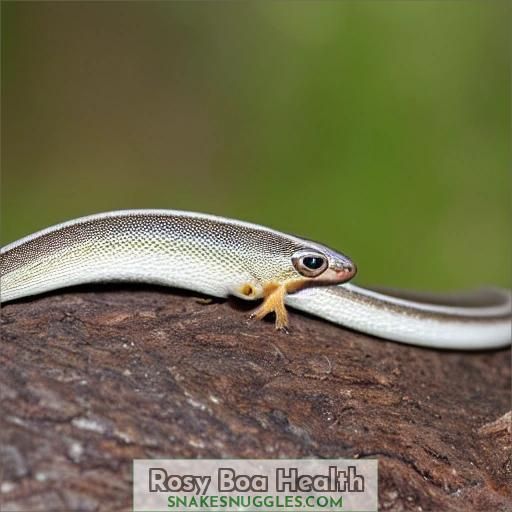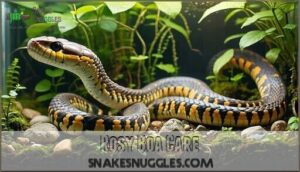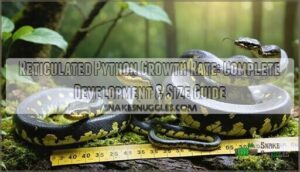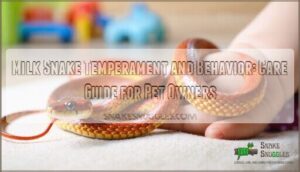This site is supported by our readers. We may earn a commission, at no cost to you, if you purchase through links.
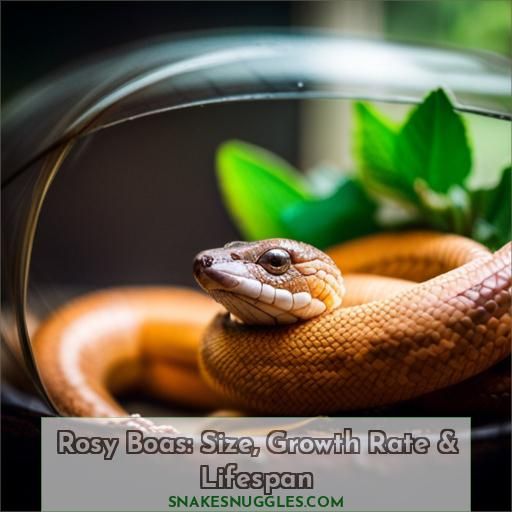
Rosy boas attain an average length of 24 inches, with a life expectancy of up to 30 years or more. Their development rate is moderate, requiring up to 30 years to attain full maturity.
As comparatively small snakes, they are a preferred option for pet owners. However, appropriate care and handling are crucial for their well-being.
If you are considering a rosy boa, be prepared to provide a safe habitat and maintain optimal environmental conditions. Additionally, you must make a long-term commitment to their care.
To acquire more knowledge about creating the ideal environment for your rosy boa and ensuring its health and happiness, continue exploring our detailed care guide.
Table Of Contents
Key Takeaways
- Rosy boas can grow up to 24 inches in length and live for over 30 years with proper care.
- They take up to 5 years to reach full maturity.
- A rosy boa’s habitat should be a minimum of 24 x 18 x 18 inches, with no gaps or access holes, and provide climbing opportunities.
- Feeding frequency is every 1-2 weeks for juveniles and every 4-6 weeks for adults, with prey size not exceeding the snake’s width.
How Long Do Rosy Boas Get and How Long It Takes to Grow?
Rosy boas can grow to be 17-36 inches in length, with some coastal specimens reaching up to 48 inches. The typical adult size for a Rosy Boa is around 24 inches. They can take 1-2 weeks to grow as juveniles and 2-4 weeks as adults.
Rosy Boa Size and Growth
Rosy boas are known to grow up to 24 inches in length and can live for over 30 years with proper care. While their average size may seem modest, these snakes can certainly live long and prosperous lives when provided the right environment.
Average Size: 24 Inches
As a Rosy Boa owner, you’ll be delighted to know that these snakes are relatively small, averaging at 24 inches in length. Their growth rate is moderate, taking up to 30 years or more to reach maturity. This size makes them a popular choice for those seeking a manageable pet snake.
Proper care and handling are essential for their well-being, including a suitable habitat, regular feeding, and cleaning.
Lifespan: Up to 30 Years or More
Rosy boas are renowned for their longevity, with an average lifespan ranging from 18 to 22 years in captivity, and some specimens enduring well into their 30s. This extended lifespan is attributed to their gentle temperament and undemanding care, rendering them a beloved choice among reptile enthusiasts.
Their lifespan is also impacted by their reproductive cycle, as they attain sexual maturity at approximately two or three years of age and give birth to live young, with an average of three to eight offspring per litter.
Appropriate care, including a balanced diet and suitable environment, can contribute to a healthy and prolonged life for these snakes.
Rosy Boa Habitat
To provide your rosy boa with a suitable habitat, you’ll need an enclosure that meets the minimum size requirements of 24 x 18 x 18 inches. This secure habitat should have no gaps or access holes, and should offer your snake ample climbing opportunities through features like rock stacks, caves, and other climbing areas.
Maintaining the proper humidity range of 40-60% is also essential for your rosy boa’s health and wellbeing.
Enclosure Size: Minimum 24 X 18 X 18 Inches
After identifying the optimal dimensions for your rosy boa’s habitat, it’s time to embark on the enjoyable aspect: adorning the enclosure. Envision it as your artistic canvas, where substrate selections establish the groundwork, and enriching activities introduce vibrant hues.
Position the water dish strategically, and establish a lighting regimen that simulates natural daylight.
A minimum 24 x 18 x 18 inches enclosure guarantees your serpentine companion experiences a sense of comfort and familiarity.
Secure Habitat: No Gaps or Access Holes
To safeguard your Rosy Boa and avert escape attempts, it’s imperative to establish a secure habitat with no gaps or access holes. Here are three steps to accomplish this:
- Escape Prevention: Seal any gaps or openings in the enclosure to hinder your snake from escaping.
- Ventilation: Ensure adequate ventilation while maintaining a secure habitat.
- Security Measures: Implement security measures such as locking mechanisms or secure lids to prevent unauthorized access to your snake’s enclosure.
Climbing Opportunities: Rock Stacks, Caves, and Climbing Areas
Enhance your Rosy Boa’s habitat with climbing enrichment, like rock stacks and caves, to provide vertical space and stimulate their natural behaviors. These features also serve as cage decoration and comfort features, increasing habitat complexity. Climbing opportunities offer behavioral stimulation, allowing your pet to engage in lengthy exploration and exercise.
Humidity: 40-60%
Humidity is critical for your rosy boa’s health. Maintain the humidity level between 40-60% to replicate its natural surroundings. Misting frequency relies on the substrate moisture and drainage setup. In a bioactive system, you may need to mist periodically. Remember, rosy boas are skilled escapists, so secure their habitat. Monitor temperature and humidity diligently, as they’re interdependent.
Rosy Boa Feeding
As a rosy boa owner, you’ll need to feed your juvenile snake every 1-2 weeks and your adult snake every 2-4 weeks. It’s important to make sure the size of the feeder mouse doesn’t go beyond the thickest part of your snake’s body.
Frequency: Juveniles Every 1-2 Weeks, Adults Every 2-4 Weeks
As a Rosy Boa owner, it’s essential to know the feeding frequency to maintain your pet’s health and development. Juveniles should be fed every 1-2 weeks, while adults can be fed every 2-4 weeks. Prey size shouldn’t be larger than the snake’s width.
Live or dead prey options are available, with day-old chicks as a special treat. Remember to handle your snake after 48 hours of eating, and you can build a trusting relationship with gentle handling.
Feeder Size: No Bigger Than the Snake’s Width
In regard to nourishing your rosy boa, consider the notion of Goldilocks – not overly substantial, not minuscule, but perfectly suited. Your meal choices shouldn’t exceed the breadth of the snake, guaranteeing an agreeable dining occasion.
For juvenile snakes, pinkies and fuzzies suffice, whereas mature snakes can manage hoppers to diminutive mice. This meticulous feeding frequency and magnitude not only forestalls IBD but also fosters a salubrious, protracted existence for your sinuous companion.
Bear in mind the rosy boa’s age, predilections for temperature, and hideouts to establish a secure, fulfilling culinary encounter.
Rosy Boa Health
Rosy boas, like many reptiles, are susceptible to various health issues that can be prevented with proper care. Here are some common health concerns and how to avoid them:
- Blister Disease: This condition is caused by poor environmental management, such as housing the boa in overly moist or dirty surroundings. Prevent blister disease by maintaining a clean and dry habitat, providing proper ventilation, and avoiding overcrowding.
- Mouth Rot and Respiratory Infections: These infections can be caused by poor sanitation and inadequate heating. Keep your boa’s habitat clean, and maintain the correct temperature range for their species.
- Inclusion Body Disease (IBD): This is a viral disease spread by snake mites. Prevent IBD by keeping your boa’s habitat clean and free of mites, and avoid introducing new snakes to an un-sanitized habitat.
- Fungal Infections: These can occur due to poor hygiene or a dirty environment. Regularly clean your boa’s habitat and make sure they’ve access to clean water.
To maintain your boa’s health, follow these guidelines:
- Regular Cleaning: Clean your boa’s habitat monthly to prevent the buildup of bacteria and parasites.
- Proper Heating: Make sure your boa’s habitat is heated to the appropriate temperature for their species to prevent respiratory infections.
- Sanitation: Keep your boa’s habitat clean and free of debris to prevent the spread of disease.
- Avoid Overcrowding: Housing multiple boas in the same habitat can increase the risk of disease transmission.
- Regular Veterinary Check-ups: Schedule routine check-ups with a reptile veterinarian to monitor your boa’s health and address any potential issues early.
Rosy Boa Handling
Gently handle your rosy boa to allow it to explore. Properly handling the snake can help develop a trusting bond over time.
Gentle Handling: Allows Exploration, Avoid Grabbing or Squeezing
Essential handling is vital for your rosy boa’s well-being. By enabling exploration, you’ll aid your pet in feeling more settled and secure in its new environment.
Refrain from seizing or constricting your snake, as this can induce stress and even harm. Remember to handle your rosy boa after 48 hours of feeding, and handle it with care to avert the release of a musk odor.
With judicious acquisition and a favorable optimal temperature zone, you’ll be well on your way to forging a trusting connection with your rosy boa.
Bonding: Can Develop a Trusting Bond
Bonding with your Rosy Boa can be a rewarding experience. By handling your snake gently and respecting its behavioral cues, you can build a trusting bond.
If your snake releases a musk odor, it may be alarmed. Handle your Rosy Boa after it has eaten and avoid grabbing or squeezing it.
Bonding takes time and patience. With consistent handling and care, your Rosy Boa may develop a trusting bond with you, enhancing its growth and well-being in its environment.
Rosy Boa Care
Maintaining a bioactive terrarium is essential for your rosy boa’s health and well-being. By incorporating a substrate like Terra Sahara, along with a clean-up crew of powder orange isopods and arid springtails, you can create a thriving and naturalistic environment that mimics the snake’s natural habitat and provides tunnels and burrows for your rosy boa to explore.
Substrate: Terra Sahara
Regarding the substrate selection for your Rosy Boa, Terra Sahara stands out as a preferred choice. This substrate caters specifically to arid to semi-arid habitats, facilitating the creation of burrows and tunnels for your reptile’s comfort. Moreover, it possesses moisture-retentive properties, which are crucial for desert-dwelling creatures to stay hydrated and fend off dehydration.
Terra Sahara comprises a blend of organic potting soil, play sand, and decomposed granite, with a ratio of 50%/25%/25%, respectively. This combination enables moisture drainage and evaporation, while leaf litter and spagnum moss capture moisture and establish microenvironments for springtails and isopods to thrive.
Should you seek alternatives to Terra Sahara, contemplate a mixture of organic potting soil, play sand, and decomposed granite in a 50%/25%/25% ratio, accompanied by leaf litter and a modest amount of spagnum moss. This combination can mimic natural conditions and foster the bioactive processes within your enclosure.
When preparing your Rosy Boa’s enclosure, ensure a substantial substrate layer, ideally exceeding 6 inches in depth, to accommodate burrowing and moisture retention. This setup promotes a self-cleaning, natural environment for your beloved pet.
Clean Up Crew: Powder Orange Isopods and Arid Springtails
In your rosy boa’s mini-world, think of Powder Orange Isopods and Arid Springtails as the cleanup crew at a garage sale, tirelessly working to maintain biodiversity and prevent a dirty environment. These microfauna champions excel in decomposition, keeping the arid ecosystem akin to their natural habitat, thereby shielding your slithery friend from diseases Mader would warn about.
A clean home equals a long, healthy snake life.
Provide Tunnels and Burrows
To offer the optimal care for your Rosy Boa, it’s essential to comprehend their burrowing requirements. Here’s a catalog of factors to take into account:
- Underground Sanctuaries: Rosy Boas require safe hiding places, so furnish them with caves, rock piles, and climbing zones.
- Burrowing Tendencies: They tend to excavate their own burrows, so make sure there are tunnels and burrows accessible.
- Digging Preferences: Offer a substrate that facilitates digging, such as Terra Sahara.
- Concealment Instincts: Inadequate care can cause stress and negative behaviors, so ensure your Rosy Boa has an environment conducive to its innate burrowing behavior.
Mimics Natural Environment by Holding Moisture
Replicating the natural environment is imperative for your Rosy Boa’s well-being. By establishing a bioactive terrarium, you can create a habitat that emulates their desert home. Utilize Terra Sahara as the substrate and incorporate a cleanup team of Powder Orange Isopods and Arid Springtails. These organisms aid in maintaining the environment by decomposing waste and regulating substrate moisture.
Furthermore, provide tunnels and burrows for your snake’s exploration, mirroring their innate burrowing tendencies. This arrangement not only fosters a sense of familiarity for your Rosy Boa but also guarantees a healthy and thriving companion.
Kit Options Available
If you’re looking for a complete kit to establish a natural habitat for your Rosy Boa, The Bio Dude offers a spectrum of options tailored to diverse enclosure dimensions. Here’s an outline of the kits accessible:
- Rosy Boa Habitat Kit – This kit is appropriate for a 10-gallon enclosure and comprises 6 quart bags of Terra Sahara soil, a compacted sphagnum moss block, oak/beech oak leaf mulch, southern palm bark, cork bark flats, and a 3-4 arid plant set. Note that this kit doesn’t include the enclosure, cleaning crew, or any UVB or heating elements your pet will require.
- Rosy Boa Plant Set – This set is ideal for providing plants that can tolerate the low humidity and elevated temperatures necessary for Rosy Boas. It includes a 3 pot with a Dude Choice Arid plant (such as haworthia, aloe, or gasteria), two 4 pots with aloe plants, and a 6 pot with a Crassula Jade or Elephant Feed plant. Plant variety may vary based on availability.
- Natural Habitat Creation for Rosy Boa – This video tutorial demonstrates establishing a natural habitat with a 24x18x18 Exo Terra enclosure, using The Bio Dude’s Terra Sahara soil, Bio Shot, AAA New Zealand Spag Moss, Large Oak Leaf Little Mix, powder orange isopods, temperate springtails, cork bark flats, and various plants and adornments. Note that this tutorial doesn’t include the enclosure itself, but provides a detailed guide on how to create a natural habitat.
These kits offer a range of options for establishing a natural habitat for your Rosy Boa, ensuring a self-sustaining environment for your pet. Remember to also provide suitable heating, UVB, and plant lights, as well as a cleaning crew and regular maintenance to keep your Rosy Boa healthy and thriving.
Frequently Asked Questions (FAQs)
What factors influence Rosy Boa growth rates?
Well, the old adage slow and steady wins the race rings true for Rosy Boas. Their growth is influenced by diet, temperature, and genetics – factors you can control to maximize their lifespan of up to 30 years.
Can Rosy Boas experience growth spurts?
Absolutely, Rosy Boas can experience growth spurts! These bursts of rapid growth are influenced by factors like genetics, diet, and environment. With proper care, you can expect your Rosy Boa to have periods of accelerated size increases.
How does breeding affect Rosy Boa size?
Breeding can notably influence a rosy boa’s size, as females will frequently grow larger to support their offspring. However, this growth may dwindle or cease after each fruitful breeding season. Don’t fret – we’ve got all the details!
Are there size differences among Rosy Boa morphs?
Ah, the eternal dance of Rosy Boa morphs! While some strut their stuff a bit taller, others take their sweet time unfurling their enchanting colors. The key? Keeping an eye on those growth spurts, my friend.
Does seasonal variation impact Rosy Boa growth?
Rosy boas’ growth can fluctuate with the seasons. During warmer months, they’ll pack on the pounds, but cool periods may slow their snappy development. Don’t fret – with proper care, they’ll reach their full size in due time.
Conclusion
Ultimately, rosy boas make for enchanting pets, but their care requires a steadfast commitment. By comprehending their average length of 24 inches, growth span up to 30 years, and distinct habitat requirements, you can furnish these snakes with a secure and stimulating environment.
Prioritize constructing a sheltered enclosure, preserving ideal humidity levels, and providing suitable feeder sizes to guarantee your rosy boa flourishes.
With the appropriate care and dedication, you can savor the rewarding experience of owning a rosy boa for many years to come.

